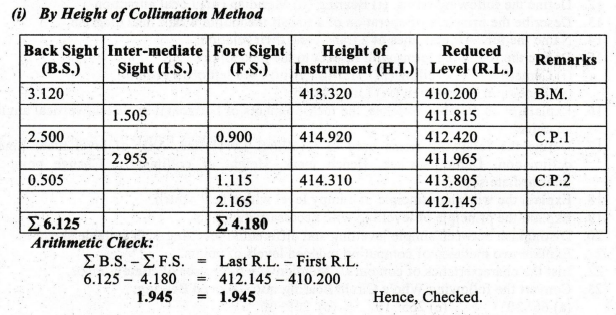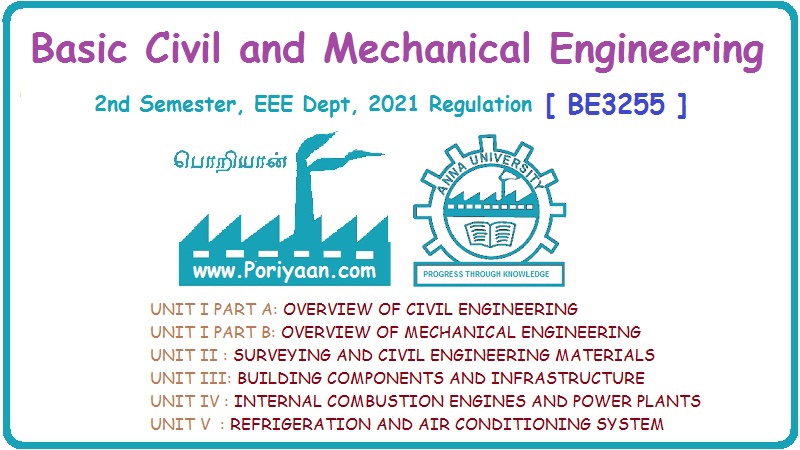Basic Civil & Mechanical Engineering: UNIT II: a. Surveying
Question Bank: Important Long Questions
Basic Civil & Mechanical Engineering: UNIT II: a. Surveying
Basic Civil & Mechanical Engineering : Chapter - 3 : Surveying : Answer the following
Chapter 3
SURVEYING
Answer the following:
1.
Explain the basic principles of surveying.
2. Give the classifications of survey. Explain
briefly.
3.
Explain the principle of chain surveying.
4.
Define the terms: (i) Tie station (ii) Check line (iii) Tie line (iv) Offset
5.
Explain the three basic operations in conducting chain surveying.
6.
Define the term: Traverse survey. How does it differ from chain survey? Discuss
the two types of traverse survey with neat sketches.
7.
Explain the principle of prismatic compass with a neat sketch. Explain the
process of taking readings using it.
8.
Explain, with a neat sketch, the construction of surveyor's compass.
9.
Distinguish between:
(i)
Fore bearing and Back bearing
(ii)
Open traverse and Closed traverse
(iii)
Prismatic compass and Surveyor's compass
(iv)
True bearing and Magnetic bearing
(v)
Whole circle bearing and Reduced bearing
(vi)
Simple levelling and Differential levelling
(vii)
Back sight and Fore sight
10.
Explain the principle of compass surveying.
11.
List the different types of leveling.
12.
Define the following terms: (i) Bearing (ii) Meridian (iii) Local attraction
13.
Describe the principle of operation of a transit theodolite with a neat
diagram.
14.
Name the fundamental lines of a transit and their relations.
15. Define the following terms with respect to
the theodolite:
(i)
Centering
(ii)
Levelling
(iii)
Transiting
(iv)
Face left observation
(v)
Face right observation
(vi)
Line of sight.
16.
Explain, with suitable sketches, the measurements of horizontal angle and
vertical angle of an object.
17.
Define the following terms used in levelling: Level line, Axis of level tube,
Line of collimation, Datum surface, Benchmark, Height of collimation, Change
point and Intermediate sight.
18.
Explain the working principle of dumpy level with a neat sketch.
19.
Explain the principle of levelling with necessary diagrams.
20.
Distinguish between simple levelling and differential levelling with suitable
sketches.
21.
Explain two methods of computing reduced levels of points.
22.
List the characteristics of contours. Mention any three uses of contour maps.
23.
Convert the following Whole Circle Bearing into Reduced Bearing:
(a)
66° 30' (c) 265° 10' (e) 205° 30'
(b)
130° 15' (d) 295° 30' (f) 320° 15'
24. Find the back bearings for the following observed fore bearings of the lines:
AB = 15° 30' PQ = N 12° 45' E
BC
= 125° 40' QR = S 46° 20' E
CD
= 210° 00' RS = S 68° 30' W
DE
= 345° 15' ST = N 81° 00' WI
Solution
When
the bearings are measured in WCB system, the fore and back bearings should
exactly differ by 180°. Therefore, B.B. = F.B. † 180°. Use +ve sign if the F.B.
is less than 180°. Use -ve sign if the F.B. is greater than 180°.

When
the bearings are measured in Q.B. system, the fore and back bearing values
remain the same except the quadrant. The quadrant has changed from NE to SW and
NW to SE.

25.
The following staff readings were
observed successively with a level, the instrument having been moved after
third, sixth and eight readings: 3.120, 1.505, 0.900, 2.500, 2.955, 1.115,
0.505, 2.165 meters. Enter the readings in a page of a level book and calculate
the R.L. of points, if the first reading was taken with a staff held on a Bench
Mark of 410.200 m.
Solution
(i) By Height of Collimation Method

(ii) By Rise and Fall Method
The
above problem may be solved by Rise and Fall Method also. The results may be arithmetically
checked.
26.
The following are the observed fore bearing of the traverse sides: AB, 80° 30';
BC, 150° 15'; CD, 270° 20'; and DE, 3250 30'. Find their back bearings.
27.
From a chain line, the following perpendicular offsets were measured to a
boundary line:

Determine
the area between the boundary and the chain line (i) By Mean Ordinate Rule (ii)
By Trapezoidal Rule and (iii) By Simpson's Rule
Answers
(i) By Mean Ordinate Rule: Area =
472.50 m2
(ii) By Trapezoidal Rule: Area =
502.00 m2 and
(iii) By Simpson's Rule: Area =
511.50 m2
Note: The number of offsets
is 8, which is even. Find the area between the first and seventh offsets by
Simpson's Rule. The area between the seventh and eighth offsets is determined
by Trapezoidal Rule.
Total Area = Area between the first offset and
seventh offset + Area between the seventh offset and eighth offset = 433 +
78.50 = 511.50 m2
Basic Civil & Mechanical Engineering: UNIT II: a. Surveying : Tag: : Basic Civil & Mechanical Engineering: UNIT II: a. Surveying - Question Bank: Important Long Questions
Related Topics
Related Subjects
Basic Civil and Mechanical Engineering
BE3255 2nd Semester 2021 Regulation | 2nd Semester EEE Dept 2021 Regulation
